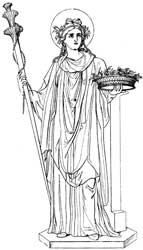Ceres

The Romans received the worship of Demeter, to whom they applied the name of Ceres, from Sicily.1 The first temple of Ceres at Rome was vowed by the dictator A. Postumius Albinus, in 496 BCE, for the purpose of averting a famine with which Rome was threatened during a war with the Latins.2 In introducing this foreign divinity, the Romans acted in their usual manner; they instituted a festival with games in honor of her,3 and gave the management of the sacred rites and ceremonies to a Greek priestess, who was usually taken from Naples or Velia, and received the Roman franchise, in order that the sacrifices on behalf of the Roman people might be offered up by a Roman citizen.4
In all other respects Ceres was looked upon very much in the same light as Tellus, whose nature closely resembled that of Ceres. Pigs were sacrificed to both divinities, in the seasons of sowing and in harvest time, and also at the burial of the dead. It is strange to find that the Romans, in adopting the worship of Demeter from the Greeks, did not at the same time adopt the Greek name Demeter. The name Ceres can scarcely be explained from the Latin language. Servius informs us,5 that Ceres, Pales, and Fortuna were the penates of the Etruscans, and it may be that the Romans applied to Demeter the name of a divinity of a similar nature, whose worship subsequently became extinct, and left no trace except the name Ceres.
The worship of Ceres soon acquired considerable political importance at Rome. The property of traitors against the republic was often made over to her temple.6 The decrees of the senate were deposited in her temple for the inspection of the tribunes of the people.7 If we further consider that the aediles had the special superintendence of this temple, it is very probable that Ceres, whose worship was like the plebeians, introduced at Rome from without, had some peculiar relation to the plebeian order. Her temple was located near the Circus Maximus in the plebeian area. Ceres' festival was the Cerealia, celebrated on April 12-19.
❧
References
Notes
- Valerius Maximus, i, 1.1.
- Dionysius of Halicarnassus. Roman Antiquities vi, 17, comp. i, 33; Tacitus. Annales ii, 49.
- Dictionary of Antiquities, s.v. Cerealia.
- Cicero. For Cornelius Balbus, 24; Festus, s.v. Graeca sacra.
- on Virgil's Aeneid ii, 325.
- Dionysius of Halicarnassus. Roman Antiquities vi, 89; viii, 79; Pliny the Elder. Naturalis Historia xxxiv, 4. s. 9; Livy. The History of Rome ii, 41.
- Livy. The History of Rome iii, 55; xxxiii, 25.
Sources
- Hartung, J.A. Die Religion der Römer. Vol. 2, p. 135 ff.
- Müller. Die Dorier ii, 10.3.
- Niebuhr, B.G. (1836). History of Rome, i, p. 621.
- Preller, L. Demeter Und Persephone: Ein Cyclus Mythologischer Untersuchungen. Hamburg, 8vo.
- Smith, William. (1870). Dictionary of Greek and Roman Biography and Mythology. London: Taylor, Walton, and Maberly.
- Welcker, F.G. Zeitschrift für Geschichte und Auslegung der alten Kunst, 1.1, p. 96 ff.
This article incorporates text from Dictionary of Greek and Roman Biography and Mythology (1870) by William Smith, which is in the public domain.